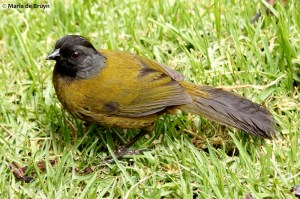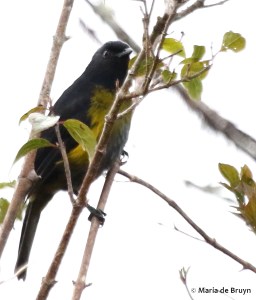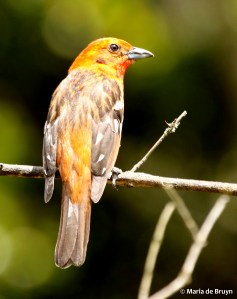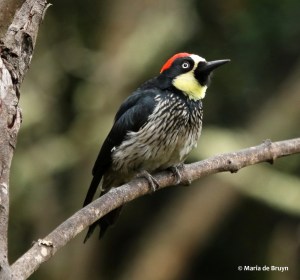No, I’m not referring to plants, humans or an anatomical feature but rather avian woodcreepers, tree creepers and woodpeckers! During our nature outings in Costa Rica in August 2019, they were definitely crowd-pleasers and reminded me of how much these birds are appreciated elsewhere, too. So today I’ll share with you some of my photos of these species in Costa Rica, The Netherlands, South Africa and the USA.
The insectivorous woodcreepers are endemic to the neotropical regions where there are some 57 different species. They tend to be brown in color and look similar, making identification a challenge at times. They hold their bodies upright, using a stiff tail (a similarity to how woodpeckers maintain a vertical position). Although they mainly look for insects in tree bark, they also will eat army ants. They have strongly clawed toes to help them cling to tree trunks.
Research has shown that the woodcreepers may use one of two techniques to capture insects. The “probers” look behind bark, mosses, lichens, leaves, etc. to find their prey. Those who engage in “sallying” launch themselves into the air to catch insects in flight after their movement up a tree has flushed them.
The plain brown woodcreeper (Dendrocincla fuliginosa) is distinguished from other woodcreepers by its lack of streaking or stripes.
The cocoa woodcreeper (Xiphorhynchus susurrans) tends to be a more solitary feeder that looks for insects in bark.
The streak-headed woodcreeper (Lepidocolaptes souleyetii) was aptly named. It tends to be a solitary probing feeder.
The wedge-billed woodcreeper (Glyphorynchus spirurus) is the smallest species of woodcreepers; it also has a shorter bill, which helps in identification. Research has shown they tend to favor ants, beetles, spiders and pseudo-scorpions for their meals.
The brown-billed scythebill (Campylorhamphus pusillus) is obviously distinguished by its very long, curved bill. It was raining and the bird was not sitting still so my photo isn’t great; I really wish I’d gotten better photos of this species (a goal for the future).
In North Carolina, we have a similar type of bird – the brown creeper (Certhia americana). I cannot hear their high-pitched call and therefore must rely on noticing movement to catch sight of them.
Watching them demands some concentration as they are continually on the move as they probe the bark and lichen. They really blend in well with the bark of their trees of choice. It’s a challenge to keep them in view.
They tend to nest in hardwood trees but prefer conifers for foraging. Like the neotropical woodcreepers, they have impressive claws to help them cling to the vertical tree trunks. An interesting fact: “By eating a single spider, a creeper gains enough energy to climb nearly 200 feet vertically.”
The short-toed treecreeper (Certhia brachydactyla) that I saw in the Hemmeland nature reserve in The Netherlands in 2018 is a similar bird. Like the brown creeper, it flies to the base of a tree and then works its way up the trunk as it searches for insects to eat. (It looks almost identical to the Eurasian treecreeper, so I hope it is identified correctly!)
The woodpeckers I’ve been able to see in Central America include several species that have similar-looking cousins further north. The golden-fronted woodpecker (Melanerpes aurifrons) has a yellow nape and patch at the base of the bill in much of its range. However, there is a Velasquez’s variant of this species that has a red cap and nape. I saw this one in a botanical garden in Quintana Roo, Mexico, in 2012.
If you look at the red-bellied woodpecker (Melanerpes carolinus), which we see a lot in North Carolina, they look quite similar.
The Hoffmann’s woodpecker (Melanerpes hoffmannii) reminds me of the red-bellied species. The males have a red crown; the females do not. With their pale yellow napes, these birds look like a “pastel” version of the red-bellied species to me.
Red heads seem to be a popular “accoutrement” for the woodpeckers. The black-cheeked species (Melanerpes pucherani), seen in Arenal, Costa Rica, this past August has a red nape but a yellow forehead.
The acorn woodpecker (Melanerpes formicivorus) has a white forehead but also sports a red patch on the back of its head. Fewer than 9% of birds engage in cooperative breeding (where several related or unrelated adults cooperate in raising broods) – the acorn woodpeckers do this through coalitions of adults who nest together.
Another woodpecker with yellow hues that I’ve had the privilege to see is the golden-tailed woodpecker (Campethera abingoni), which I saw in Kruger National Park in South Africa in 2009. Like the above-mentioned woodpeckers, in this species the male also has red hues on its head.
In North Carolina, two very similar smaller woodpeckers are characterized by males who sport a small red patch on the back of the head and females who lack the red coloring. The hairy woodpecker (Leuconotopicus villosus, below left) is the larger of the two species; the downy (Picoides pubescens) looks almost identical except that it is slightly smaller, has a shorter bill and no white spots on the outside tail feathers.
 The endangered red-cockaded woodpecker (Dryobates borealis) looks like a larger version of the hairy and downy birds but it lacks any red patches anywhere on the head. Their common name refers to an almost invisible red streak (“cockade”) at the top of white cheek where it meets the black feathers atop the head. Unfortunately, this species (the only woodpeckers to make their nest holes in living trees) is under increased threat as the US Fish and Wildlife Service may remove some of the protective measures that have helped increase the population.
The endangered red-cockaded woodpecker (Dryobates borealis) looks like a larger version of the hairy and downy birds but it lacks any red patches anywhere on the head. Their common name refers to an almost invisible red streak (“cockade”) at the top of white cheek where it meets the black feathers atop the head. Unfortunately, this species (the only woodpeckers to make their nest holes in living trees) is under increased threat as the US Fish and Wildlife Service may remove some of the protective measures that have helped increase the population.
The great spotted woodpecker male (Dendrocopos major) that I saw in The Netherlands in 2018 does have a red patch on the back of its head; as in other woodpecker species, the females lack the red spot. This species also sports an obvious red belly (much more so than the red-bellied woodpecker!). An interesting feature of this woodpecker is that they undergo a complete moult after breeding that lasts up to 120 days.
The rufous-winged woodpecker (Piculus simplex, right) only put in a very brief appearance this past August, but made it obvious that they, too, have a red crown. The golden-olive woodpecker (Colaptes rubiginosus) continued the red accented plumage – the males complement their crimson crown with a red “moustachial” stripe. There are 19 sub-species with slightly different coloration.
The large lineated woodpecker (Dryocopus lineatus, left) in Costa Rica closely resembles the pileated woodpeckers (Dryocopus pileatus, right) that we have in North Carolina. The males of both species can be distinguished by the red stripe going down their faces and both types of woodpeckers are known for their drumming.
 The pale-billed woodpeckers (Campephilus guatemalensis) looks a bit like the lineated and pileated species but they are even larger birds that feature an entirely red head. The adults have a light-colored beak that gives them their common name; immature birds have darker bills that lighten with age. The females can be distinguished by their black instead of red throats.
The pale-billed woodpeckers (Campephilus guatemalensis) looks a bit like the lineated and pileated species but they are even larger birds that feature an entirely red head. The adults have a light-colored beak that gives them their common name; immature birds have darker bills that lighten with age. The females can be distinguished by their black instead of red throats.
We were lucky to see a pair of these birds foraging along a large stream, accompanied by a third bird – perhaps one of their young from the previous breeding season? This species has not been studied thoroughly – for example, the incubation period and time from hatching to fledging are still both unknown.
Finally, I’ll end this long blog with two more woodpeckers that we saw in Costa Rica. There were smoky brown woodpeckers (Dryobates fumigatus) in a couple places we visited but it was difficult for me to get a good photo in the overcast rainy conditions. They are rather plain birds but again the males are distinguished by a red cap. These were in a tree with black-cheeked woodpeckers.
I had a bit more luck photographing the chestnut-colored woodpecker (Celeus castaneus). This attractive bird has reddish brown plumage and a shaggy crest. Its head feathers may be lighter in color and the males have bright red cheeks.
As there are a couple more woodpecker species where I live that I also enjoy seeing, I’ll feature them in the next blog (a shorter one!) Have a nice day!









































































































